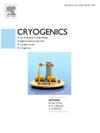Numerical evaluation of mechanical response in Bi-2223 coil under complicated loadings
IF 1.8
3区 工程技术
Q3 PHYSICS, APPLIED
引用次数: 0
Abstract
A high-strength Bi-2223 Type HT-NX (reinforced with Ni-alloy) wire has been developed and commercialized. This tape is of significant utility in nuclear magnetic resonance (NMR) and other high magnetic field applications, as it is able to provide a stable magnetic field due to its multi-filamentary properties, which serves to reduce the screening effect. In this study, the external reinforcement of the Bi-2223 tape can extend the critical strain of the internal filaments, which is derived from residual strain caused by the difference of various thermal expansion coefficients during the preparation and cooling processes. To obtain electromagnetic and mechanical behaviors of the Bi-2223 coil in high field, a finite element numerical simulation based on the H-formulation is proposed. There are two modeling geometries adopted for the simulation, one is the mono-filamentary geometry in the homogenization model, and the other is the multi-filamentary geometry. The mechanical behavior of the two models differs significantly with regard to the magnetization. For the charging process, the difference will decrease with the increase of the charging current. Moreover, the cumulative strain of the coil under the combined action of winding, cooling and electromagnetic force is analyzed comprehensively. Finally, the numerical results of coil in varying positions for the two models will also be influenced by alterations in the parallel and vertical fields.
求助全文
约1分钟内获得全文
求助全文
来源期刊

Cryogenics
物理-热力学
CiteScore
3.80
自引率
9.50%
发文量
0
审稿时长
2.1 months
期刊介绍:
Cryogenics is the world''s leading journal focusing on all aspects of cryoengineering and cryogenics. Papers published in Cryogenics cover a wide variety of subjects in low temperature engineering and research. Among the areas covered are:
- Applications of superconductivity: magnets, electronics, devices
- Superconductors and their properties
- Properties of materials: metals, alloys, composites, polymers, insulations
- New applications of cryogenic technology to processes, devices, machinery
- Refrigeration and liquefaction technology
- Thermodynamics
- Fluid properties and fluid mechanics
- Heat transfer
- Thermometry and measurement science
- Cryogenics in medicine
- Cryoelectronics
 求助内容:
求助内容: 应助结果提醒方式:
应助结果提醒方式:


